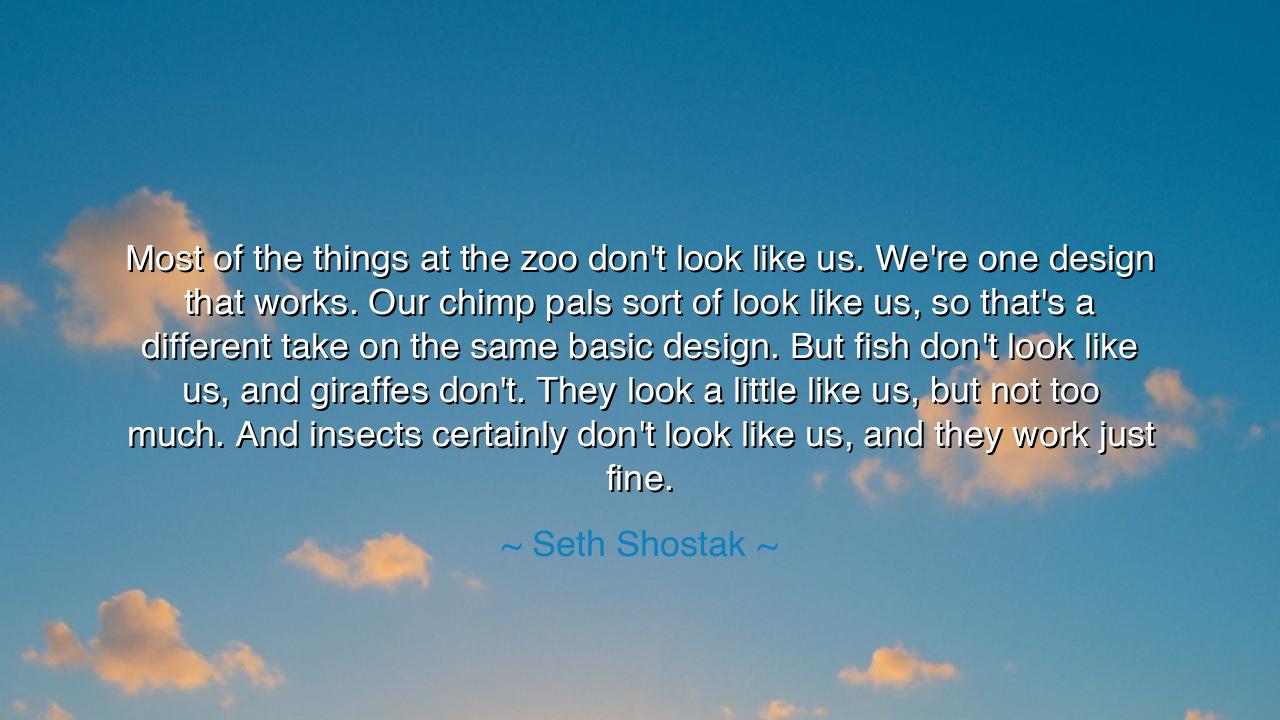
Most of the things at the zoo don't look like us. We're one
Most of the things at the zoo don't look like us. We're one design that works. Our chimp pals sort of look like us, so that's a different take on the same basic design. But fish don't look like us, and giraffes don't. They look a little like us, but not too much. And insects certainly don't look like us, and they work just fine.






"Most of the things at the zoo don't look like us. We're one design that works. Our chimp pals sort of look like us, so that's a different take on the same basic design. But fish don't look like us, and giraffes don't. They look a little like us, but not too much. And insects certainly don't look like us, and they work just fine." – Seth Shostak
In this reflection, Seth Shostak, the scientist and seeker of life beyond Earth, reminds us of a truth both humbling and profound: that life wears many faces, and no single form holds the monopoly on perfection. He speaks as one who has gazed into the cosmos and seen in its vastness the folly of human arrogance. When he says “we’re one design that works,” he honors the wonder of our existence — but also places it within the infinite tapestry of creation. For though humankind often views itself as the pinnacle of design, the universe whispers otherwise: that life thrives in endless forms, each suited perfectly to its purpose.
The origin of this quote lies in Shostak’s work as an astronomer and senior scientist with the SETI Institute — the great modern search for extraterrestrial intelligence. His gaze is not bound to Earth, and thus he sees our form not as the rule, but as one of countless possibilities. In contemplating alien life, he invites us to first look around — at the zoo, at the sea, at the forests. There we find the sacred diversity of life, from the elegant stride of the giraffe to the glimmering dance of fish and the intricate genius of the insect. Each is proof that function, not form, is the truest mark of success. The universe is not limited by a single model; it celebrates variation as the expression of divine imagination.
To the ancients, this truth was self-evident. The philosopher Heraclitus taught that the logos — the cosmic order — manifests in many ways, each perfect in its place. The eagle is no less perfect than the lion, nor the tree than the star. So too does Shostak’s vision echo this ancient wisdom: the divine does not repeat itself, it creates endlessly. Humanity, then, must not mistake its reflection for the image of all life. Just as the stars differ in brightness yet belong to one sky, so every living being differs in form yet shares one essence — the spark of life itself.
Consider the story of Charles Darwin, who voyaged to the Galápagos and saw how the same species took on countless shapes to fit its environment. The finch became the embodiment of adaptability — one design, infinitely varied. From this revelation grew the understanding that evolution is not a march toward perfection, but a dance of adaptation. The giraffe’s long neck, the fish’s fins, the insect’s wings — each a response to life’s call, each a triumph of necessity over vanity. Darwin, like Shostak centuries later, beheld in this diversity the quiet genius of creation.
And yet, Shostak’s message carries a deeper echo still — a challenge to human pride. We are not the measure of all things. We are but one pattern among billions, and the cosmos does not bend itself to our image. The beings of distant worlds, if they exist, may not resemble us at all — and why should they? Life adapts to its world; it does not demand the world adapt to it. To believe otherwise is to forget our place in the grand order, to mistake our design for destiny. The wise recognize that humility is the beginning of understanding.
This awareness calls for reverence. When we gaze upon a butterfly, a whale, or an ant, we should see not something lesser, but something different — and therefore sacred. The spider’s web, delicate yet strong, is a poem written in silk. The ant’s colony, small yet organized, mirrors our cities. The fish’s shimmering scales rival the stars in beauty. Nature’s designs are not hierarchies, but harmonies. Each creature is a note in the symphony of life, and without even one, the song would lose its balance.
Lesson: Let this truth settle in your heart — that life’s greatness lies in diversity, not in likeness to ourselves. Honor all forms of being, for each expresses the wisdom of existence in its own way. Do not seek to judge by appearance, nor to believe that only your form is divine. Instead, open your eyes to the wonder of difference — in nature, in people, in the stars. For the universe, vast and ancient, has shown us that what is alien may still be beautiful, and what is unlike us may yet work just fine — perhaps even better.






AAdministratorAdministrator
Welcome, honored guests. Please leave a comment, we will respond soon